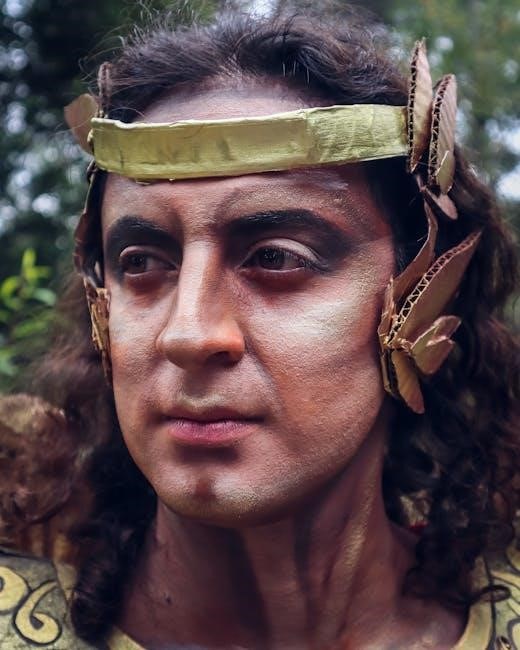Joseph Campbell’s seminal work explores the universal monomyth, revealing how hero stories across cultures share a common structure, inspiring modern storytelling in film, literature, and psychology.
Overview of the Book and Its Significance
Hero of a Thousand Faces is a groundbreaking cross-cultural study of mythological themes by Joseph Campbell. The book explores the universal monomyth, a shared narrative pattern found in stories across time and cultures. Campbell identifies the hero’s journey as a central structure, where protagonists face challenges, undergo transformation, and return transformed. This concept has inspired countless works in literature, film, and psychology, making it a foundational text for understanding storytelling. Its significance lies in its ability to bridge cultural divides, revealing common human experiences and aspirations. The book remains a vital resource for scholars, writers, and anyone exploring the depth of myth and its relevance to modern life.
Joseph Campbell’s Contribution to Mythology
Joseph Campbell revolutionized the study of mythology by identifying the universal patterns that underpin stories across cultures. His concept of the hero’s journey, detailed in Hero of a Thousand Faces, revealed a shared narrative structure that transcends cultural boundaries. By bridging comparative mythology, psychology, and literature, Campbell’s work has profoundly influenced fields such as film, psychology, and storytelling. His ideas have inspired iconic works like Star Wars and continue to shape modern storytelling. Campbell’s contribution lies in his ability to illuminate the common human experiences and aspirations that lie at the heart of myths, making his work timeless and universally relevant.

The Origin of the Hero’s Journey
The hero’s journey, rooted in universal patterns, originates from Campbell’s analysis of cross-cultural myths, influenced by figures like Carl Jung and James George Frazer.
Historical Context and Cross-Cultural Analysis
Campbell’s work traces the historical roots of the hero’s journey, drawing from myths worldwide, including Greek, Egyptian, and Native American traditions. His comparative approach highlights shared patterns, such as the call to adventure, challenges, and transformation, revealing a universal monomyth. By analyzing myths from diverse cultures, Campbell demonstrates how these stories reflect collective human experiences and psychological truths. This cross-cultural analysis underscores the timelessness of the hero’s journey, showing its relevance across time and geography. Campbell’s insights have profound implications for understanding human storytelling and its role in shaping cultures and identities.
Universal Themes in Mythological Stories
Mythological stories worldwide share universal themes, such as the hero’s journey, sacrifice, and redemption. These narratives often depict a protagonist facing existential challenges, symbolizing humanity’s collective struggles. The hero’s journey, as outlined by Campbell, features stages like the call to adventure, trials, and transformation, reflecting deep psychological truths. Themes of good vs. evil, self-discovery, and the quest for meaning resonate across cultures, highlighting shared human experiences. These stories also explore symbolic elements like the mentor figure, the underworld, and the return with newfound wisdom. Campbell’s analysis reveals how these universal themes transcend time and culture, speaking to fundamental aspects of the human condition.
Joseph Campbell’s Life and Work
Joseph Campbell, born in 1904, was a renowned mythologist whose work explored comparative mythology and the human experience. His academic background in literature and languages shaped his research, drawing inspiration from Carl Jung and James George Frazer. Campbell’s fascination with mythological patterns led him to develop the concept of the monomyth, which he detailed in “Hero of a Thousand Faces.” His work bridges academia and popular culture, influencing fields beyond mythology, including psychology and storytelling. Campbell’s legacy continues to resonate, offering insights into the universal themes that unite human narratives across cultures and time.
Biographical Sketch and Academic Background
Joseph Campbell, born in 1904, was a renowned American mythologist and scholar. His early fascination with mythology and comparative religion led him to study at Columbia University, where he developed a deep interest in literature and languages. Campbell’s academic pursuits were influenced by scholars like Arthur Rackham and James George Frazer, whose works shaped his understanding of universal mythological themes. His groundbreaking book, “Hero of a Thousand Faces,” published in 1949, introduced the concept of the monomyth, a unifying narrative pattern across cultures. Campbell’s later life included a successful career as a professor, public speaker, and writer, cementing his legacy in the field of mythology;
Key Ideas and Inspirations Behind the Book
Joseph Campbell’s “Hero of a Thousand Faces” introduces the monomyth, a universal narrative pattern found in hero stories across cultures. The book explores the Hero’s Journey stages: the call to adventure, challenges, and return home. Campbell drew inspiration from Carl Jung’s collective unconscious and archetypes, recognizing shared mythological themes. He analyzed diverse myths, folklore, and literature to identify these patterns. The work bridges psychology, anthropology, and storytelling, revealing deep cultural connections. This interdisciplinary approach has made the monomyth a foundational concept in understanding universal human experiences.

The Structure of the Hero’s Journey
The Hero’s Journey is a universal narrative framework, detailing stages like departure, initiation, and return. It captures the hero’s transformation and resonates across cultures and time.
The Call to Adventure and Its Significance
The call to adventure initiates the hero’s transformative journey, often through an unexpected event or summons. This stage signifies a departure from the ordinary world, compelling the hero to embrace change and face challenges. It is a pivotal moment that sets the story in motion, symbolizing the universal human experience of being called to explore the unknown. Campbell emphasizes its importance as the catalyst for growth and self-discovery, highlighting how it transcends cultural boundaries, appearing in myths, legends, and modern narratives alike. The call to adventure is thus a cornerstone of the monomyth, driving the hero toward their destined path.
Thresholds and Challenges in the Journey
Thresholds and challenges are pivotal in the hero’s journey, marking transitions into unknown territories and testing their resolve. These stages often involve overcoming physical, emotional, or spiritual obstacles, which are universal across cultures. Campbell highlights how these trials force the hero to confront fear, weakness, and transformation. Mentors and allies often aid the hero during these phases, providing guidance or magical tools. The challenges serve as a crucible for growth, refining the hero’s character and preparing them for the ultimate ordeal. This phase emphasizes the psychological struggle of balancing the ordinary and special worlds, illustrating the human capacity for resilience and adaptation in the face of adversity.
Key Concepts in “Hero of a Thousand Faces”
Joseph Campbell’s work introduces the monomyth, a universal pattern in hero stories, emphasizing transformative journeys, symbolic quests, and the hero’s psychological and cultural significance in storytelling.
The Ordinary World and the Special World
The ordinary world represents the hero’s familiar environment, where they face mundane challenges and initial reluctance to embark on a journey. The special world, in contrast, is a realm of wonder and danger, where the hero confronts transformative trials and discovers their true potential. This duality underscores the universal theme of growth through adversity, as seen in myths and stories across cultures. The transition between these worlds symbolizes the hero’s inner and outer evolution, making it a cornerstone of Campbell’s monomyth structure and its enduring appeal in modern storytelling.
The Role of Mentors and Allies in the Journey
Mentors and allies play a crucial role in guiding the hero through their transformative journey. These figures often possess wisdom, experience, or magical aid, helping the hero navigate challenges and understand their purpose. Mentors may appear as wise sages, while allies can be loyal companions or even symbolic guides. Their roles are pivotal in preparing the hero for the trials ahead, offering encouragement, and providing critical insights or tools. This support system underscores the importance of collaboration and guidance in the hero’s quest, highlighting the universal theme of assistance in times of need. Their contributions are essential to the hero’s growth and ultimate success.

Influence and Legacy of the Book

Joseph Campbell’s “Hero of a Thousand Faces” has profoundly shaped storytelling, inspiring films, literature, and psychology, while its universal themes continue to resonate globally.
Impact on Literature, Film, and Psychology
Joseph Campbell’s “Hero of a Thousand Faces” has revolutionized storytelling across mediums. In literature, authors like George Lucas and J.R.R. Tolkien drew inspiration from the monomyth, crafting iconic narratives. Filmmakers widely adopt the Hero’s Journey structure, shaping blockbusters from Star Wars to The Matrix. In psychology, Carl Jung’s influence on Campbell is evident, linking the hero’s transformation to human consciousness and personal growth. The book’s principles are also applied in psychology, helping individuals navigate life’s challenges through mythic frameworks. Its enduring influence underscores the universality of human experiences, making it a cornerstone in understanding storytelling and the human psyche.
Modern Applications of the Hero’s Journey
The Hero’s Journey remains a powerful framework in modern storytelling, marketing, and personal development. It is widely used in filmmaking, with many blockbusters adhering to its structure. In business, companies apply the monomyth to craft compelling brand narratives. Educators incorporate it into curriculum design, helping students engage with stories on a deeper level. Psychologists use it to guide individuals through personal growth and transformation. Additionally, the Hero’s Journey inspires video game design, political campaigns, and even social media storytelling. Its versatility continues to resonate, proving its relevance in understanding human experiences and fostering connection in a digital age. Its timeless appeal ensures its enduring influence across diverse fields.
Psychological and Cultural Significance
Campbell’s work reveals how myths reflect universal human experiences, bridging psychology and culture. Carl Jung’s archetypes and the collective unconscious deeply influenced his ideas, highlighting shared human truths across time and societies.
Carl Jung’s Influence on Campbell’s Work
Carl Jung’s concept of the collective unconscious and archetypes significantly shaped Campbell’s understanding of universal myths. Jung’s ideas about shared human experiences across cultures resonated deeply with Campbell, influencing his development of the hero’s journey. Campbell integrated Jungian psychology into his analysis, emphasizing how myths reflect psychological truths. The notion of archetypes, such as the Hero and the Mentor, became central to Campbell’s framework. This fusion of psychology and mythology allowed Campbell to explore how stories tap into humanity’s shared emotional and psychological landscapes, making his work profoundly impactful across disciplines.
Cultural Universality and Human Psychology
Campbell’s work highlights the cultural universality of mythological themes, revealing shared human experiences across time and geography. Drawing from Carl Jung’s concept of the collective unconscious, Campbell demonstrates how myths reflect universal psychological truths. Stories from diverse cultures feature similar patterns, such as the hero’s journey, illustrating a shared human psyche. This universality suggests that myths fulfill deep psychological needs, offering insights into personal growth, transformation, and the struggle between light and darkness. By exploring these commonalities, Campbell bridges cultural divides, showing how myths resonate with fundamental aspects of human nature, making them timeless and universally relatable.
Campbell’s “Hero of a Thousand Faces” remains a cornerstone of mythological study, offering timeless insights into human psychology and storytelling, continuing to inspire creators globally today.
Relevance of “Hero of a Thousand Faces” Today
Joseph Campbell’s “Hero of a Thousand Faces” remains a vital resource in modern storytelling, psychology, and cultural studies. Its exploration of the universal hero’s journey continues to inspire filmmakers, writers, and psychologists, offering a framework for understanding human experiences. The book’s insights into mythological patterns are widely applied in personal development, helping individuals navigate life’s challenges. Its influence is evident in popular culture, from Hollywood blockbusters to literary masterpieces. As a timeless guide to the human condition, Campbell’s work bridges ancient myths with contemporary relevance, making it a indispensable tool for anyone exploring the depths of storytelling and human psychology in the 21st century.